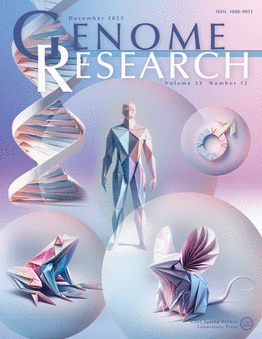Differences in activity and stability drive transposable element variation in tropical and temperate maize
IF 6.2
2区 生物学
Q1 BIOCHEMISTRY & MOLECULAR BIOLOGY
引用次数: 0
Abstract
Much of the profound interspecific variation in genome content has been attributed to transposable elements (TEs). To explore the extent of TE variation within species, we developed an optimized open-source algorithm, panEDTA, to de novo annotate TEs in a pangenome context. We then generated a unified TE annotation for a maize pangenome derived from 26 reference-quality genomes, which reveals an excess of 35.1 Mb of TE sequences per genome in tropical maize relative to temperate maize. A small number (n = 216) of TE families, mainly LTR retrotransposons, drive these differences. Evidence from the methylome, transcriptome, LTR age distribution, and LTR insertional polymorphisms reveals that 64.7% of the variability is contributed by LTR families that are young, less methylated, and more expressed in tropical maize, whereas 18.5% is driven by LTR families with removal or loss in temperate maize. Additionally, we find enrichment for Young LTR families adjacent to nucleotide-binding and leucine-rich repeat (NLR) clusters of varying copy number across lines, suggesting TE activity may be associated with disease resistance in maize.热带和温带玉米转座元件变异的活性和稳定性差异
转座元件(TEs)在基因组内容上的深刻种间差异中占了很大一部分。为了探索物种内 TE 的变异程度,我们开发了一种优化的开源算法--panEDTA,用于在泛基因组背景下重新注释 TE。然后,我们为来自26个参考质量基因组的玉米泛基因组生成了统一的TE注释,发现热带玉米每个基因组的TE序列比温带玉米多35.1 Mb。这些差异是由少数(n = 216)TE 家族(主要是 LTR 反转座子)造成的。来自甲基组、转录组、LTR年龄分布和LTR插入多态性的证据显示,64.7%的变异是由热带玉米中年轻、甲基化较少和表达较多的LTR家族贡献的,而18.5%的变异是由温带玉米中移除或丢失的LTR家族驱动的。此外,我们还发现,年轻的 LTR 家族富集在各品系拷贝数不同的核苷酸结合和富亮氨酸重复(NLR)簇附近,这表明 TE 活性可能与玉米的抗病性有关。
本文章由计算机程序翻译,如有差异,请以英文原文为准。
求助全文
约1分钟内获得全文
求助全文
来源期刊

Genome research
生物-生化与分子生物学
CiteScore
12.40
自引率
1.40%
发文量
140
审稿时长
6 months
期刊介绍:
Launched in 1995, Genome Research is an international, continuously published, peer-reviewed journal that focuses on research that provides novel insights into the genome biology of all organisms, including advances in genomic medicine.
Among the topics considered by the journal are genome structure and function, comparative genomics, molecular evolution, genome-scale quantitative and population genetics, proteomics, epigenomics, and systems biology. The journal also features exciting gene discoveries and reports of cutting-edge computational biology and high-throughput methodologies.
New data in these areas are published as research papers, or methods and resource reports that provide novel information on technologies or tools that will be of interest to a broad readership. Complete data sets are presented electronically on the journal''s web site where appropriate. The journal also provides Reviews, Perspectives, and Insight/Outlook articles, which present commentary on the latest advances published both here and elsewhere, placing such progress in its broader biological context.
 求助内容:
求助内容: 应助结果提醒方式:
应助结果提醒方式:


